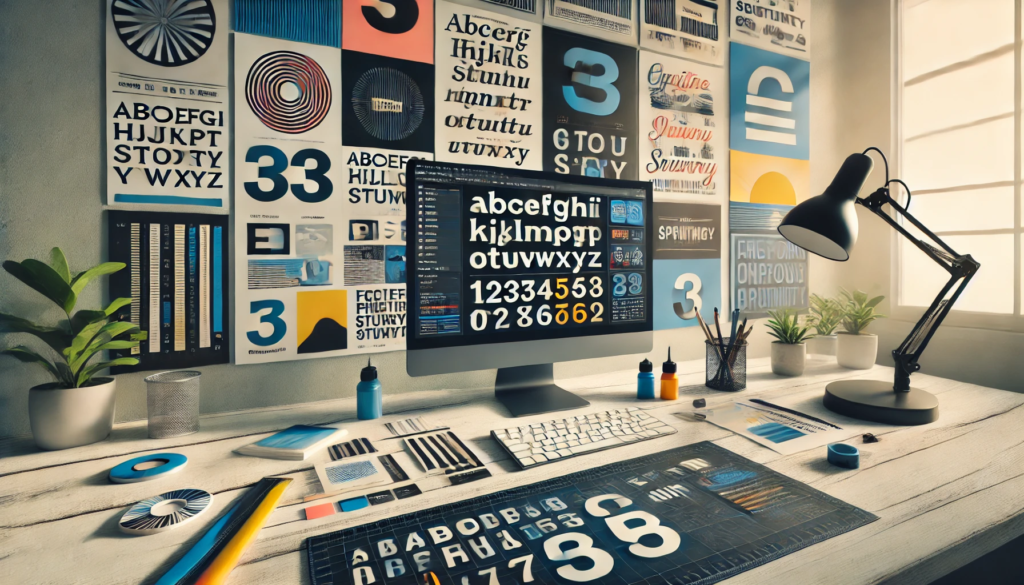Typography is more than just selecting a font for a design. It’s an essential element that directly impacts readability, visual hierarchy, and the overall aesthetics of a project. When used effectively, typography guides the viewer’s attention, sets the tone of the design, and strengthens the message. Whether designing websites, logos, or marketing materials, understanding how to work with type is critical to creating polished, professional designs.
This article explores key principles and techniques for using typography effectively in graphic design. From font selection to text alignment, we’ll delve into how designers can leverage typography to enhance communication and make their projects visually compelling.
Choosing the Right Typeface
Understand the Role of Typeface Categories
Before diving into a project, it’s important to choose a typeface that aligns with the design’s purpose. Typefaces are typically categorized into the following groups:
- Serif: Serif fonts have small lines or strokes attached to the ends of letters (e.g., Times New Roman, Georgia). These are often seen as formal, traditional, and reliable, making them popular for print materials like newspapers, books, and official documents.
- Sans-Serif: Sans-serif fonts (without the small lines) like Arial, Helvetica, and Roboto are cleaner and more modern. They are widely used in web and digital design due to their readability on screens.
- Script: Script fonts mimic handwritten styles and are more decorative. These fonts are often used sparingly for invitations, logos, or headers that require a touch of elegance or personality.
- Display: Display fonts are decorative and highly stylized, designed for short, impactful use, such as in headlines or logos. They often create a distinct visual identity but should be used cautiously to avoid overwhelming the design.
Choosing the right typeface depends on the tone of the project. A corporate brochure might call for a clean, sans-serif typeface, while an invitation to a formal event might benefit from an elegant script font.
Pairing Fonts
Font pairing is the art of selecting two or more fonts that work well together in a design. Effective font combinations can add contrast and depth while maintaining harmony. When pairing fonts, consider the following:
- Contrast vs. Complement: Choose fonts that contrast enough to create interest, but complement each other stylistically. For example, pairing a serif font with a sans-serif font can create a balanced yet dynamic contrast.
- Hierarchy and Roles: Use different fonts for different roles. One font might be used for headings (bold and prominent), while another is used for body text (subtle and readable). This ensures clarity and guides the viewer’s attention.
- Avoid Overloading: Stick to a maximum of two to three fonts. Using too many fonts can create a chaotic, cluttered design and reduce readability.
Tools like Google Fonts or Typekit provide font pairing suggestions, helping designers select combinations that align with their design goals.
Establishing Visual Hierarchy
Visual hierarchy is the arrangement of elements in a way that signifies importance. In typography, it’s about using font size, weight, and placement to ensure that the most critical information is noticed first. When text is laid out thoughtfully, it enhances both the aesthetics and functionality of a design.
Size and Scale
The size of your text is one of the most obvious ways to create hierarchy. Larger fonts naturally draw attention, making them ideal for headlines, titles, or any text that needs to stand out. Smaller text is typically used for body copy, where readability over long sections of text is important.
- Headlines: Should be the largest element on the page, drawing the eye immediately.
- Subheadings: Use slightly smaller fonts than the headline but larger than the body text. This acts as a bridge between the main heading and detailed content.
- Body Text: Should be smaller, typically between 12–16 points for print or digital designs, ensuring legibility without overwhelming the reader.
Font Weight and Style
Font weight refers to the thickness of the characters. By using varying weights (light, regular, bold, extra bold), you can emphasize different parts of the text. For example, bold type can be used for headings or to highlight important keywords in body text.
Italic and underline styles are also tools for emphasis but should be used sparingly. Overusing these styles can diminish their impact and make the design look busy.
Color and Contrast
Color is a powerful tool for establishing hierarchy in typography. By using color contrasts, you can highlight key elements while ensuring that all text is readable. A simple rule is to maintain high contrast between text and its background—dark text on a light background or vice versa. Accent colors can be used to emphasize certain words or phrases.
When using multiple colors, ensure they are consistent with the brand or theme of the design. Too many contrasting colors can reduce the readability and coherence of your text.
Kerning, Leading, and Tracking: Managing Space in Typography
The spacing between letters and lines can significantly impact readability and the overall look of the text. Proper spacing makes text easier to read and ensures the design looks balanced.
Kerning
Kerning refers to the adjustment of space between individual characters. Poor kerning can make text appear uneven and unpolished. Adjusting the kerning ensures that the spacing between letters looks visually balanced. This is especially important for large headlines, logos, or when using stylized fonts.
- Tight Kerning: Suitable for bold, all-caps headlines where space is limited.
- Loose Kerning: Used when readability is key, such as in small body text or elegant, formal designs.
Leading
Leading (also known as line-height) is the space between lines of text. Proper leading enhances readability, especially in paragraphs, by giving the eyes room to move from one line to the next.
- Tight Leading: Can make text feel cramped and hard to read, especially in body copy.
- Loose Leading: Creates a more open, airy feel and improves legibility but should not be so loose that it feels disconnected.
A good rule of thumb is to set leading at 120–150% of the font size for body text.
Tracking
Tracking is the overall spacing between letters in a block of text. While kerning adjusts the space between specific pairs of letters, tracking affects all letters equally. Adjusting tracking can alter the density of text, making it feel more open or compact depending on the desired effect.
- Tight Tracking: Works well for bold, uppercase headings or where space is limited.
- Loose Tracking: Used for decorative or display text where the design requires a lighter, more spacious feel.
Alignment and Consistency
Consistency in alignment is key to creating a professional and organized design. Aligning text correctly ensures that the design looks structured and polished.
Left, Right, and Center Alignment
Most text is left-aligned, as this is the easiest for readers to follow, especially in Western languages. Right alignment is often used for decorative or stylized text but can make long sections of text difficult to read. Center alignment is useful for headings, logos, or minimal text layouts but should be used sparingly in large blocks of text, as it can disrupt the flow of reading.
Grid Systems
Using a grid system ensures that all elements in your design, including text, images, and graphics, are aligned consistently. Grids create order and structure, ensuring that the text feels balanced and proportionate across different sections of the design.
For example, a 12-column grid is popular in web design, ensuring that all elements fall into a clean, logical layout. A well-applied grid system also makes responsive design easier, as it allows you to rearrange text and elements without losing alignment.
Readability: Enhancing the User Experience
No matter how creative your design is, it must be readable to be effective. Readability refers to how easy it is to read and understand your text. There are several factors that can influence readability, including font choice, size, and spacing.
Avoiding Long Line Lengths
Long lines of text are difficult to read, as they require the eye to travel further across the page. For optimal readability, aim for line lengths of 50–75 characters. Keeping lines shorter improves comprehension and allows for a more comfortable reading experience.
Font Size for Readability
While large, bold fonts work well for headlines, body text should be set at a size that’s easy to read, especially on smaller screens. For print, a font size between 10-12 points works well for most text-heavy documents. For websites, use 16px or larger for body copy, as screen resolution can affect readability.
Contrast and Legibility
Ensuring good contrast between text and background is essential for readability. Light-colored text on a light background can be hard to see, just as dark text on a dark background reduces legibility. Use high-contrast color combinations (e.g., black text on white) to make your typography clear and easy to read.
Additionally, avoid complex backgrounds behind text. If you’re using an image as a background, overlay a solid or semi-transparent background to ensure the text stands out.
Typography in Branding and Design Systems
Typography is a fundamental component of brand identity. The fonts and styles you choose help convey the personality of a brand and set the tone for how it communicates with its audience.
Creating a Consistent Typeface Hierarchy
Design systems often include specific guidelines for typography, ensuring that fonts are used consistently across all media—web, print, advertising, and more. A consistent hierarchy not only enhances brand identity but also improves the user experience by maintaining uniformity across platforms.
Custom Fonts and Brand Personality
For larger brands, creating custom fonts can be a powerful way to stand out and strengthen brand recognition. Custom fonts are designed specifically for a brand’s needs, ensuring that the typeface reflects the company’s values and personality.
For smaller businesses, choosing an existing font family that aligns with the brand’s image is essential. Consistently using the same fonts across all platforms—social media, websites, packaging—helps build a cohesive brand identity.
Conclusion
Typography is a powerful tool in graphic design that goes beyond simply choosing fonts. It involves creating balance, hierarchy, and clarity while enhancing the visual appeal of your work. By understanding the principles of type selection, pairing, spacing, and alignment, designers can craft text that not only looks good but also communicates effectively.
Whether you’re designing a website, a brand logo, or a marketing campaign, mastering typography ensures that your designs are not only aesthetically pleasing but also functional, readable, and aligned with your overall message.
FAQ
What is the difference between serif and sans-serif fonts?
Serif fonts have small lines or strokes attached to the ends of letters, giving them a more formal and traditional look. Sans-serif fonts lack these lines and are considered cleaner and more modern, making them popular in digital designs.
How can I pair fonts effectively?
To pair fonts effectively, choose contrasting styles that complement each other. For example, pairing a bold serif font for headings with a clean sans-serif font for body text creates a balanced, readable design.
What is the importance of kerning in typography?
Kerning adjusts the space between individual letters, improving the overall appearance and readability of the text. Proper kerning ensures that text doesn’t look uneven or too tightly spaced.
How does visual hierarchy impact typography?
Visual hierarchy arranges text elements based on their importance, using size, weight, and color to guide the reader’s attention. Headings should be larger and bolder, while body text should be smaller and more subtle.
What is the role of typography in branding?
Typography is a key component of branding, helping to convey the personality and values of a brand. Consistent use of fonts across all media creates a cohesive and recognizable visual identity.
How can I improve the readability of my text?
To improve readability, use appropriate font sizes, limit line lengths to 50–75 characters, ensure good contrast between text and background, and choose fonts that are clear and legible.

